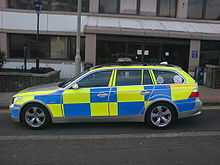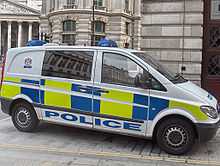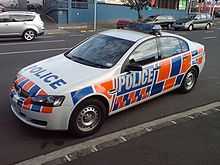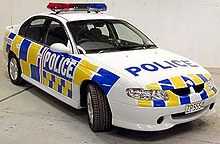Battenburg markings
Battenburg markings are a pattern of high-visibility markings used primarily on the sides of emergency service vehicles in several European countries, Australia, New Zealand, and Hong Kong. The name comes from the similarity in appearance to the cross-section of a Battenberg cake.
History
Battenburg markings were originally developed in the mid-1990s in the UK by the Police Scientific Development Branch (PSDB) (now the Home Office Scientific Development Branch (HOSDB)) at the request of the national motorway policing sub-committee of the Association of Chief Police Officers. They were first developed for the United Kingdom police forces to use on traffic patrol cars, although other private organisations and civil emergency services have since started to use the pattern on their vehicles.
The brief was to create a livery for motorway and trunk road police vehicles which would maximise the visibility of the vehicles when stopped on scene, both in daylight, and under headlights from a minimum distance of 500 metres (1,600 ft), and which would distinctively mark it as a police car.[1]
The key research objectives included:
- Enhance officer and public safety by reducing the likelihood of road accidents where conspicuity of the police vehicle is a factor
- Be recognisable as a police vehicle up to a distance of 500 metres (1,600 ft) in normal daylight
- Assist in high visibility policing so as to reassure the public and enhance the potential deterrent benefits of proactive traffic patrol activity
Conspicuity

The Battenburg design uses a regular pattern and the contrast between a light and a dark colour to increase conspicuity for the human eye. The lighter colour is daylight-fluorescent (such as fluorescent-yellow) in better visibility in daytime and particularly also in dusk and dawn. For night-time visibility, the complete pattern is retroreflective.
The Battenburg design typically has two rows of alternating rectangles, usually starting with yellow at the top corner, then the alternating colour, along the sides of a vehicle. Most cars use two block rows in the design (so-called Full-Battenburg scheme). Some designs for cars only use a single row (so-called Half-Battenburg scheme) or one-and-a-half row.
Patterns markings can have a camouflage effect as well concealing the outline of the vehicle, particularly in front of a cluttered background. [2][3] For Battenburg markings, this can be avoided by the following means:
- The pattern rectangles shall not be too small in order to allow for optical resolution from distance. The rectangle size shall be 600 x 300 mm at minimum.[1] A typical car pattern consists of seven blocks along the vehicle side. (Additionally, an odd number of blocks allows for both top corner blocks to be in the same fluorescent colour)
- The vehicle outline of a car shall be clearly marked out in fluorescent colour along the roof pillars
- Designs with more than two block rows shall be avoided even for higher vehicles. Instead, large area of plain or daylight-fluorescent color can be used in combination.
- Hybrid designs of Battenburg markings and other high-visibility patterns or check patterns shall be avoided.[4]
The Battenburg livery is not used on the rear of vehicles, instead with the majority of users using upward facing chevrons in yellow and red to the rear, in line with the markings used by other road users.
Sillitoe Tartan

During the development of Battenburg markings, one of the key functions was to clearly identify a vehicle as being linked to the police. In addition to the advantages in effectiveness tests, the pattern was also reminiscent of the Sillitoe Tartan pattern of black-and-white or blue-and-white chequered markings, first introduced by the City of Glasgow Police in the 1930s, and subsequently adopted as a symbol of police services as far away as Chicago and Australia.
Subsequent to the launch of the markings of the vehicles, the police introduced retro-reflective Sillitoe tartan markings to their uniforms, usually in blue and white.
While Sillitoe tartan pattern used to mark police vehicles as such, it is not a high-visibility pattern.
Usage
United Kingdom


In the United Kingdom, the majority of the emergency services have adopted the Battenburg style of markings, with nearly half of all police forces adopting the markings within three years of its introduction, and over three quarters using it by 2003.[1]
In 2004, following the widespread adoption and recognition of the Battenburg markings on police vehicles, the Home Office subsequently recommended that all police vehicles, not just those on traffic duty, be marked up with a "half-Battenburg" livery which formalised a position which had already been undertaken by a number of forces.
In the United Kingdom, the emergency services have chosen or been given certain colours which identify them, with the police continuing to use the blue, whereas UK ambulances tend to use green, and the fire service use red.
The use of these colours in retro-reflective material is controlled by the Road Vehicle Lighting Regulations 1989, with vehicles only legally allowed the use of yellow retro-reflective material, although the emergency services operate under temporary special orders under section 44 of the Road Traffic Act 1988 to use their own colours, with moves currently underway to formalise this in legislation and extend the use of other colours to civilian operators.[5][6] However, a number of civilian organisations have adopted the pattern, which is not legally protected, and a number of these also use other retro-reflective colours.
An alternative to the use of retro-reflective materials is the use of fluorescent markings, or other non-reflective markings, which at least in the United Kingdom can be used by any vehicle, regardless of ownership or purpose.
| Common Battenburg markings used in the United Kingdom | ||
| |
Police | Yellow / Blue |
| |
Ambulance and doctors | Yellow / Green |
| |
Fire and Rescue | Yellow / Red |
| |
Blood Bikes | Yellow / Orange |
| |
National Blood Service | Yellow / Orange |
| |
Highways Agency and VOSA | Yellow / Black |
| |
Rail response | Blue / Orange |
| |
Mountain rescue | White / Orange |
| |
HM Coastguard | Yellow / Navy Blue |
Hong Kong
Some emergency vehicles and special vehicles in the Hong Kong Police Force, Hong Kong Fire Services Department, Auxiliary Medical Service, and Hong Kong St. John Ambulance use Battenburg markings.
| Common Battenburg markings used in Hong Kong | ||
| |
Police Force, Traffic Branch Headquarters | Yellow / Blue |
| |
Police Force, a few other vehicles | White / Blue |
| |
Fire Services Department, Mobile Casualty Treatment Centre | Yellow / Green |
| Fire Services Department, Hazmat Tender, and Fire Motorcycle | Yellow / Red | |
| Fire Services Department, Mobile Publicity Unit, and Fire Safety Education Bus | ||
| Fire Services Department, Emergency Medical Assistant Motor Cycle, and Paramedic Equipment Tender | ||
| |
Fire Services Department, Mobile Command Unit, and Forward Command Car | White / Red |
| Auxiliary Medical Service, Paramedic motorcycle | Yellow / Green | |
| Hong Kong St. John Ambulance, Ambulance | ||
Ireland

In Ireland, a similar system to the UK is used with some variations.
| Common Battenburg markings used in Ireland | ||
| |
Garda Síochána | Yellow / Blue |
| |
HSE National Ambulance Service | Yellow / Green |
| |
Fire Brigade | Yellow / Red |
| |
Civil Defence | Blue / Orange |
New Zealand


The New Zealand Police currently use yellow/blue Battenburg markings, as well as cars in standard factory colors. Prior to October 2008, orange and blue were for general duties vehicles while yellow and blue was reserved for highway patrol units. The orange and blue color scheme will be phased out by 2014, and all vehicles will use the yellow and blue color scheme.[7]
Sweden

Originally Swedish Police vehicles were painted with black roofs and doors or black roofs, bonnet, and boot. This was a necessity due to the heavy snows Sweden experiences. During the 1980s the cars became white with the word "Polis" written on the side in a semi-futuristic typeface. Later the livery became simply blue and white, then in 2005 was changed to a light blue and fluorescent yellow Battenburg livery. Most Swedish police cars are either Volvos or Saabs, with the same livery all over Sweden. A recent Swedish trend is to also use Battenburg markings on road maintenance vehicles. These are then marked with orange/blue, as in the UK rail response type shown above. A study by the Swedish Road Administration show a significant traffic calming effect when using orange/blue Battenburg marking to improve the visibility of road maintenance vehicles.[8]
| Common Battenburg markings used in Sweden | ||
| |
Police | Yellow / Blue |
| |
Ambulance | Yellow / Green |
| |
Fire Brigade | Yellow / Red |
| |
Road maintenance | Blue / Orange |
Switzerland
The first Swiss ambulance service with Battenburg markings is the emergency medical services in Zofingen. Since 2008 they have Battenburg markings on a Volkswagen Crafter and a Mercedes Sprinter. They use white/red coloured markings on their ALS units. Another service with similar Battenburg markings is the Swiss Border Patrol. They use lemon on blue markings.
See also
- Sillitoe Tartan
- Aerial roof markings
- Blues and twos
- Panda car
- Jam sandwich (police car)
References
- ↑ 1.0 1.1 1.2 Harrison, Paul (2004). "High-Conspicuity Livery for Police Vehicles". Home Office.
- ↑ "Emergency Vehicle Visibility and Conspicuity Study, FA-323". U.S. Department of Homeland Security. August 2009. Retrieved 2015-01-26.
- ↑ "The difference between Battenburg high-visibility markings and Sillitoe chequers on Police, Fire & Ambulance vehicles". 2012-04-27. Retrieved 2015-01-26.
- ↑ "Evaluating new trends in emergency vehicle markings". Retrieved 2015-01-26.
- ↑ "Road Vehicles Lighting Regulations 1989: Schedule 17".
- ↑ Burrows, Adrian (2008-03-07). "Impact Assessment of the Road Vehicle Lighting Regulations covering reflective markings on emergency vehicles". Department for Transport.
- ↑ Binning, Elizabeth (11 November 2008). "Arresting image update to save police force $800,000". New Zealand Herald.
- ↑ "Improved visibility of road maintenance vehicles using Battenburg markings (report in Swedish)".
External links
![]() Media related to Battenburg markings at Wikimedia Commons
Media related to Battenburg markings at Wikimedia Commons